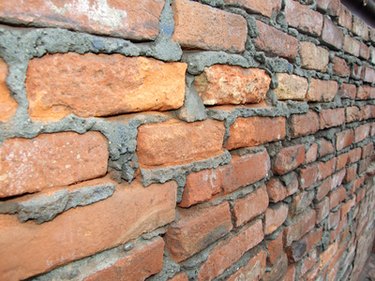
From the beginning of early construction, architects of all regions used bricks to build. While the first bricks, adobe bricks, were made of dirt and straw, later bricks were made from clay and fired in a kiln to increase their durability. Masonry bricks have a history that can be traced back centuries and even to other countries depending on the type of brick and the age of the original building. Many historical homes still have the original brick, shipped from Europe during the 1600's. In many restoration or repair projects, contractors and homeowners may find it useful to know the history of their masonry bricks.
Step 1
Examine the brick for surface details. Although you may not find many, handmade bricks from early construction periods will have uneven shapes, may contain straw or grass markings, and will be larger than brick made today. Handmade bricks are still made today, but the process is costly and inefficient for large manufacturers.
Video of the Day
Step 2
Feel along the top of the brick. Newer bricks made after the 1600's have an indentation called a frog to hold mortar for laying. Waterstruck or solid brick will not have this feature, but are generally smoother in shape with a lip on the edge. Although older brick will not have a frog, waterstruck brick will be too smooth and uniform, reflecting their mechanically pressed production process.
Step 3
Look for identifying marks that will give you important information about the masonry brick's construction. Manufacturers will often stamp the company name or location of the quarry onto the face of the brick or in the frog depression.
Step 4
Inspect the color and surface textures of the brick. Variations in color and fold lines indicate bricks fired in clamp kilns, which were used in early manufacturing and created unevenness in color and texture. Today, most bricks are cut from an elongated pliable clay form. They are then dried and fired in a closed kiln at nearly 2,000-degrees.
Step 5
Take note of the brick's location in the house. During the 18th century, some construction methods built wood framed homes and used brick to fill in the gaps between the woodwork as insulation. Homes built between 1810 and 1900 used bricks as insulation.
Tip
If you were restoring a home, the first place to check would be the recorder’s office for your city. They should be able to identify when your home was built, which will provide information about the bricks used during construction.
Take a sample brick to the local masonry yards and ask them for help identifying the masonry’s age and manufacturer. They may also be able to perform chemical analysis of the brick to determine its construction process and materials which can offer greater insight about the age.
Warning
Do not remove a brick from a building without properly supporting other bricks on the wall. Loose brick or brick with failing mortar will fall easily and cause personal injury.
Video of the Day